最新英文科技写作技巧与时态表达总结
如何撰写英文科技论文时态与语态部分
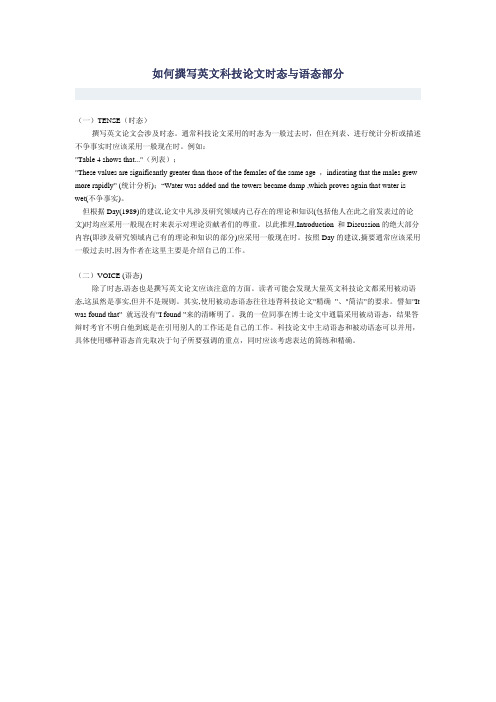
如何撰写英文科技论文时态与语态部分(一)TENSE(时态)撰写英文论文会涉及时态。
通常科技论文采用的时态为一般过去时,但在列表、进行统计分析或描述不争事实时应该采用一般现在时。
例如:"Table 4 shows that..."(列表);"These values are significantly greater than those of the females of the same age ,indicating that the males grew more rapidly” (统计分析);“Water was added and the towers became damp ,which proves again that water is wet(不争事实)。
但根据Day(1989)的建议,论文中凡涉及研究领域内已存在的理论和知识(包括他人在此之前发表过的论文)时均应采用一般现在时来表示对理论贡献者们的尊重。
以此推理,Introduction 和Discussion的绝大部分内容(即涉及研究领域内已有的理论和知识的部分)应采用一般现在时。
按照Day的建议,摘要通常应该采用一般过去时,因为作者在这里主要是介绍自己的工作。
(二)VOICE (语态)除了时态,语态也是撰写英文论文应该注意的方面。
读者可能会发现大量英文科技论文都采用被动语态,这虽然是事实,但并不是规则。
其实,使用被动态语态往往违背科技论文"精确”、"简洁”的要求。
譬如"It was found that” 就远没有"I found ”来的清晰明了。
我的一位同事在博士论文中通篇采用被动语态,结果答辩时考官不明白他到底是在引用别人的工作还是自己的工作。
科技论文中主动语态和被动语态可以并用,具体使用哪种语态首先取决于句子所要强调的重点,同时应该考虑表达的简练和精确。
最新英文科技写作表达总结
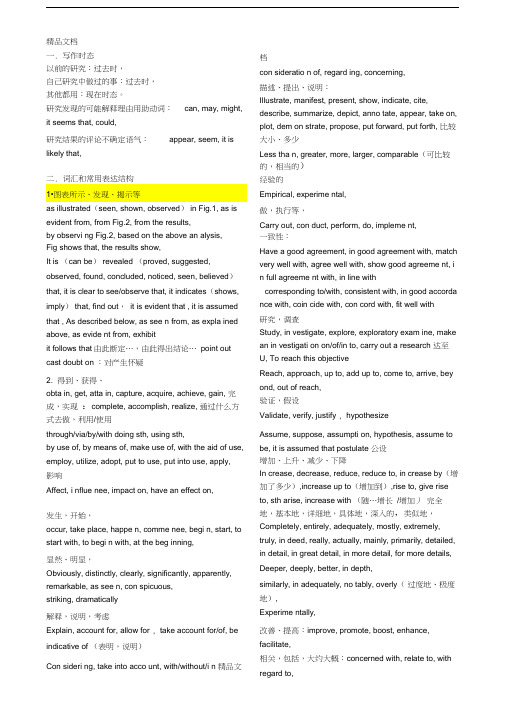
精品文档一.写作时态以前的研究:过去时,自己研究中做过的事:过去时,其他都用:现在时态。
研究发现的可能解释理由用助动词:can, may, might, it seems that, could,研究结果的评论不确定语气:appear, seem, it is likely that,as illustrated(seen, shown, observed) in Fig.1, as is evident from, from Fig.2, from the results,by observi ng Fig.2, based on the above an alysis,Fig shows that, the results show,It is (can be) revealed (proved, suggested, observed, found, concluded, noticed, seen, believed)that, it is clear to see/observe that, it indicates(shows, imply) that, find out,it is evident that , it is assumed that , As described below, as see n from, as expla ined above, as evide nt from, exhibitit follows that由此断定…,由此得出结论… point out cast doubt on :对产生怀疑2. 得到、获得、obta in, get, atta in, capture, acquire, achieve, gain, 完成,实现:complete, accomplish, realize, 通过什么方式去做,利用/使用through/via/by/with doing sth, using sth,by use of, by means of, make use of, with the aid of use, employ, utilize, adopt, put to use, put into use, apply,影响Affect, i nflue nee, impact on, have an effect on,发生,开始,occur, take place, happe n, comme nee, begi n, start, to start with, to begi n with, at the beg inning,显然、明显,Obviously, distinctly, clearly, significantly, apparently, remarkable, as see n, con spicuous,striking, dramatically解释,说明,考虑Explain, account for, allow for , take account for/of, be indicative of (表明,说明)Con sideri ng, take into acco unt, with/without/i n 精品文档con sideratio n of, regard ing, concerning,描述、提出、说明:Illustrate, manifest, present, show, indicate, cite, describe, summarize, depict, anno tate, appear, take on, plot, dem on strate, propose, put forward, put forth, 比较大小、多少Less tha n, greater, more, larger, comparable(可比较的,相当的)经验的Empirical, experime ntal,做,执行等,Carry out, con duct, perform, do, impleme nt,一致性:Have a good agreement, in good agreement with, match very well with, agree well with, show good agreeme nt, i n full agreeme nt with, in line withcorresponding to/with, consistent with, in good accorda nce with, coin cide with, con cord with, fit well with研究,调查Study, in vestigate, explore, exploratory exam ine, make an in vestigati on on/of/in to, carry out a research 达至U, To reach this objectiveReach, approach, up to, add up to, come to, arrive, bey ond, out of reach,验证,假设Validate, verify, justify , hypothesizeAssume, suppose, assumpti on, hypothesis, assume to be, it is assumed that postulate 公设增加、上升、减少、下降In crease, decrease, reduce, reduce to, in crease by(增加了多少),increase up to(增加到),rise to, give rise to, sth arise, increase with (随…增长/增加)完全地,基本地,详细地,具体地,深入的,类似地,Completely, entirely, adequately, mostly, extremely, truly, in deed, really, actually, mainly, primarily, detailed, in detail, in great detail, in more detail, for more details, Deeper, deeply, better, in depth,similarly, in adequately, no tably, overly(过度地、极度地),Experime ntally,改善、提高:improve, promote, boost, enhance, facilitate,相关,包括,大约大概:concerned with, relate to, with regard to,精品文档Be involved in/with, with respect to, be concerned with, as for,Around, about, approximately,决定:determ ine, decide, depe nd on ,rely on目的、试图:an attempt to, aim at, in an attempt to, the objective is, in order to, the aim of is tothe aim of this research is to do the purpose is , be aimed at,经历,保持:hold, keep, undergo, experienee, remain, retai n,导致:cause, in duce, lead to, result in, origi nate from, arise from,根据,基于:accord ing to, in terms of, i n the light of, judge by, on the basis of, i n view of, based on,On behalf of, in the form of, referring to, with refere nee to, i n refere nee to除了:other than, apart from, with the exception of, except for/that, besides, in additi on, additi on ally, 理论上,事实上:in principle, in practice, in fact, in reality, in theory, theoretically,从某种程度上:|To some exte nt, to a large/certa in exte nt, i n a way, in a sen se, to some degree, in some sen se,from the viewpo ints of , from the perspective of, 得出结论:draw a conclusion, come to/reach a con clusi on,推断,猜测:Infer,derive from, deduce, speculate,认为,当作Con sider as, regard as, refer to as,建立模型establish, create,build,run/do the simulatio nin the case of : 在… 情况下遵循趋势:obey, follow trend, tendency ,组成con sist of , contain, be composed of, i nclude,强调:highlight, emphasize, lay emphasis on , the emphasis is layed on集中:focus on, concentrate on , be centered on 设定为to set to be辨另U、区分:d iscern, differentiate , identify as,其他专业词汇表达small batch product ion, small qua ntity product ion, high volume product ion, mass product ion, metal-formed product, micro-formed part, reproducibility: 再现性、重复性experimental determination, in particular, especially, 评估,评价:evaluate, assess,扮作:act as,分离,隔绝,separate from, isolate, set apart from 缺少:in the abse nee of by convention :按照传统,惯例,使成为:make sth sthno Ion ger (不再)but rather(相反的) be typical of (典型的)成反比:in versely scale with 涉及,牵涉至U: in volve, cover,拓展:exte nd into 最近,新近more recently , 到目前为止,迄今to date,解释、提示原因或结果的转接词:attribute to, because, as a result of, therefore, thereby, in gen eral, con seque ntly, as predicted, in con clusi on, sin ce, as for, fin ally, hen ce, thus, as, for, due to, in summary, because of, when, cause, on account of, result in, owing to, con tribute to, tha nks to, lead to, the reas on is, that is because, devoted to, accord in gly, as a con seque nee of, arise from起逻辑演进作用的转接词:递进关系,不但…而且…等Furthermore, in additi on, besides, first, sec ond, third, fin ally, lastly, moreover, i ncide ntally, in fact, i n truth, as a matter of fact, for example, such as, next, then, for in sta nee, take an in sta nee of , likewise/as such(同样),again(此外),at root, as well as, as follows, in the follow ing, below, based on, above, above-me nti on ed, aforementioned, as with(正如,与一样,就来说),as noted(正如前面所提到的),additi on ally,in parallel, as stated(如上所述) meanwhile :同时对比词,表示逻辑演进方向即将改变如但是等But, however, in stead, n evertheless, despite, surprisingly, in spite of, nonetheless, in/by contrastto/with , for comparis on, whereas, while, even though, 精品文档although, compared with, regardless of, as compared to, with regard to, in relation to, by contrast, irrespective of, in comparis on to与联系,联合:in associati on with同时, 同样的,at the same time, in the same way, in the same time对应关系A vs.B versus三.英文研究论文中的表达句子substitute equation (1) into equation (2)把代入等式The scale in Fig (a) runs from black for low values to white for the highest Schmid factors.offers more in sight i nto,holds for all three materials,四.英文科技论文中的语言技巧,不可不看a) 如何指出当前研究的不足以及有目的地引导出自己的研究的重要性通常在叙述了前人成果之后,用However来引导不足,比如However, little in formati on..little atte ntio n...little work...little datalittle researchor few studiesfew in vestigati on s...few researchers...few attempts...or nonone of these studieshas (have) bee n lessdone on ...focused onattempted tocon ductedin vestigatedstudied(with respect to) Previous research (studies, records) has (have) failed to con siderignoredmisi nterpretedn eglected tooverestimated, un derestimatedmisleadedthus, these previous results areincon clusive, misleadi ng, un satisfactory, questi on able, con troversial..Un certa in ties (discrepa ncies) still exist ...这种引导一般提出一种新方法,或者一种新方向。
英文科技写作方法

英文科技写作方法要想与国外同仁共享自己的成果,用英文写作必不可少。
写英文科技有什么方法呢?XX(1) 题目:概括性强、体现创新性、精炼题目写作注意事项:英文题目以短语为主要形式,尤以名词短语最常见,即题目基本上由一个或几个名词加上其前置和(或)后置定语构成。
例如: The fabrication of 。
短语型题目要确定好中心词,再进行前后修饰。
**个词的顺序很重要,词序不当,会导致表达不准。
题目一般不应是陈述句,因为题目主要起标示作用,而陈述**易使题目具有式的语义;况且陈述句不够精练和醒目,重点也不易突出。
少数情况(评述性、综述性和驳斥性)下可以用疑问句做题目,因为疑问句可有探讨性语气,易引起读者兴趣。
题目中的缩略词语:已得到整个科技界或本行业科技人员公认的缩略词语,才可用于题目中,否则不要轻易使用。
另外,还要注意题目字数的限制,国外科技期刊一般对题目字数有所限制,这些规定可供我们参考。
总的原则是,题目应确切、简练、醒目,在能准确反映特定内容的前提下,题目词数越少越好。
(2)摘要:XX与结论不重复,体现整个文章的结论和思想,包括研究工作的目的、方法、结果和应用等。
XX摘要写作注意事项:摘要是以提供文献内容梗概为目的,不加评论和补充解释,简明、确切地记述文献重要内容的短文。
其基本要素包括研究目的、方法、结果和结论。
具体地讲,就是研究工作的主要对象和范围,采用的手段和方法,得出的结果和重要的结论,有时也包括具有价值的其它重要的信息。
摘要应具有性和自明性,并且拥有与文献同等量的主要信息,即不阅读全文,就能获得必要的信息。
我审稿时碰到作者的结论性错误,Microelectroc Engineering期刊的那篇,后来我给他指出错误并给他,不要轻易下结论,这很糟糕的。
我就觉得这个作者文献还是看少了,特别是理论性的西,所以他下错误结论。
后来在修稿中改正了。
XX IEEETransactions on nents and PackagingTechnologies的那篇,我认为作者没有好好解释实验结果,图中曲线的解释不是很好。
科技英语作文总结
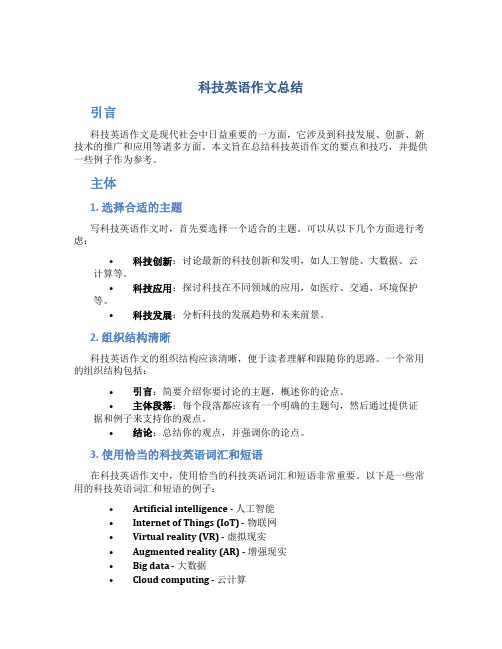
科技英语作文总结引言科技英语作文是现代社会中日益重要的一方面,它涉及到科技发展、创新、新技术的推广和应用等诸多方面。
本文旨在总结科技英语作文的要点和技巧,并提供一些例子作为参考。
主体1. 选择合适的主题写科技英语作文时,首先要选择一个适合的主题。
可以从以下几个方面进行考虑:•科技创新:讨论最新的科技创新和发明,如人工智能、大数据、云计算等。
•科技应用:探讨科技在不同领域的应用,如医疗、交通、环境保护等。
•科技发展:分析科技的发展趋势和未来前景。
2. 组织结构清晰科技英语作文的组织结构应该清晰,便于读者理解和跟随你的思路。
一个常用的组织结构包括:•引言:简要介绍你要讨论的主题,概述你的论点。
•主体段落:每个段落都应该有一个明确的主题句,然后通过提供证据和例子来支持你的观点。
•结论:总结你的观点,并强调你的论点。
3. 使用恰当的科技英语词汇和短语在科技英语作文中,使用恰当的科技英语词汇和短语非常重要。
以下是一些常用的科技英语词汇和短语的例子:•Artificial intelligence - 人工智能•Internet of Things (IoT) - 物联网•Virtual reality (VR) - 虚拟现实•Augmented reality (AR) - 增强现实•Big data - 大数据•Cloud computing - 云计算•Blockchain technology - 区块链技术•Genetic engineering - 基因工程•Nanotechnology - 纳米技术4. 提供实例和证据支持观点在科技英语作文中,为了增加可信度和说服力,应该提供实例和证据来支持你的观点。
例如:。
如何在科技论文中使用时态
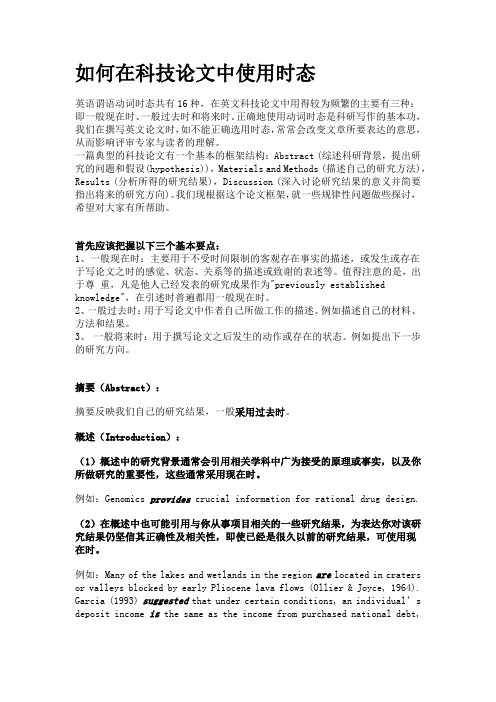
如何在科技论文中使用时态英语谓语动词时态共有16种,在英文科技论文中用得较为频繁的主要有三种:即一般现在时、一般过去时和将来时。
正确地使用动词时态是科研写作的基本功,我们在撰写英文论文时,如不能正确选用时态,常常会改变文章所要表达的意思,从而影响评审专家与读者的理解。
一篇典型的科技论文有一个基本的框架结构:Abstract (综述科研背景,提出研究的问题和假设(hypothesis)),Materials and Methods (描述自己的研究方法),Results (分析所得的研究结果),Discussion (深入讨论研究结果的意义并简要指出将来的研究方向)。
我们现根据这个论文框架,就一些规律性问题做些探讨,希望对大家有所帮助。
首先应该把握以下三个基本要点:1、一般现在时:主要用于不受时间限制的客观存在事实的描述,或发生或存在于写论文之时的感觉、状态、关系等的描述或致谢的表述等。
值得注意的是,出于尊重,凡是他人已经发表的研究成果作为"previously established knowledge",在引述时普遍都用一般现在时。
2、一般过去时:用于写论文中作者自己所做工作的描述。
例如描述自己的材料、方法和结果。
3、一般将来时:用于撰写论文之后发生的动作或存在的状态。
例如提出下一步的研究方向。
摘要(Abstract):摘要反映我们自己的研究结果,一般采用过去时。
概述(Introduction):(1)概述中的研究背景通常会引用相关学科中广为接受的原理或事实,以及你所做研究的重要性,这些通常采用现在时。
例如:Genomics provides crucial information for rational drug design.(2)在概述中也可能引用与你从事项目相关的一些研究结果,为表达你对该研究结果仍坚信其正确性及相关性,即使已经是很久以前的研究结果,可使用现在时。
英语科技论文表述中常用的时态
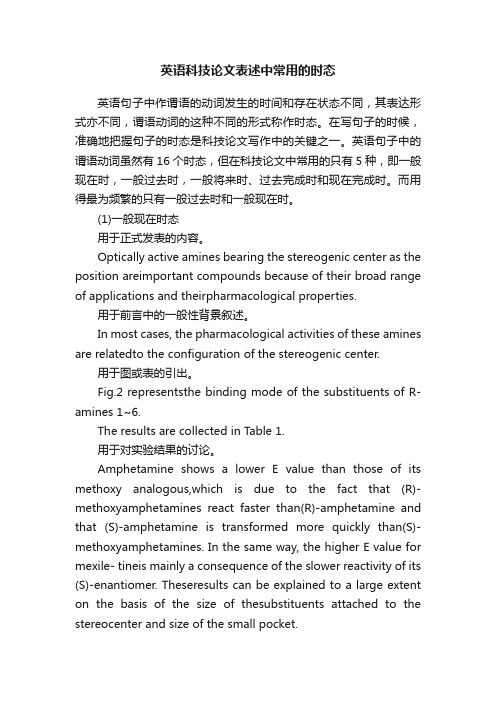
英语科技论文表述中常用的时态英语句子中作谓语的动词发生的时间和存在状态不同,其表达形式亦不同,谓语动词的这种不同的形式称作时态。
在写句子的时候,准确地把握句子的时态是科技论文写作中的关键之一。
英语句子中的谓语动词虽然有16个时态,但在科技论文中常用的只有5种,即一般现在时,一般过去时,一般将来时、过去完成时和现在完成时。
而用得最为频繁的只有一般过去时和一般现在时。
(1)一般现在时态用于正式发表的内容。
Optically active amines bearing the stereogenic center as the position areimportant compounds because of their broad range of applications and theirpharmacological properties.用于前言中的一般性背景叙述。
In most cases, the pharmacological activities of these amines are relatedto the configuration of the stereogenic center.用于图或表的引出。
Fig.2 representsthe binding mode of the substituents of R-amines 1~6.The results are collected in Table 1.用于对实验结果的讨论。
Amphetamine shows a lower E value than those of its methoxy analogous,which is due to the fact that (R)-methoxyamphetamines react faster than(R)-amphetamine and that (S)-amphetamine is transformed more quickly than(S)-methoxyamphetamines. In the same way, the higher E value for mexile- tineis mainly a consequence of the slower reactivity of its (S)-enantiomer. Theseresults can be explained to a large extent on the basis of the size of thesubstituents attached to the stereocenter and size of the small pocket.用于一般性真理的描述。
英文科技文章写作方法总结

英文文章阅读总结1、题目(title)题目主要包含目的或者信息,吸引读者,不能太长。
例如:Evaluation of the Miscibility and Contribution of Flue Gas to Oil Recovery Under High Pressure Air Injection. 这个题目首先说明了文章的目的- Evaluation of the Miscibility and Contribution of Flue Gas to Oil Recovery,而High Pressure Air Injection既告诉读者研究的范围,又起到吸引读者的作用。
2、摘要(abstract)摘要主要包含四部分:研究工作的目的,方法,结果,结论。
摘要中不出现“本文”,“我们”“作者”等字眼,也不一般不出现“首次”,“最后”,“简单”,“主要”和“次要”等修饰词。
摘要中一般不出现的缩写词,出现的话需要解释一下。
摘要最大的特点就是简单、直接并且可以概括统领全文。
下面这个例子很好的说明了英文摘要写作特点:An experimental study was carried out to investigate the mechanism and contribution of miscible displacement, by in situ generated flue gases, to the recovery of light oil in reservoirs undergoing HPAI. The flue gas displacements were carried out on recombined reservoir oil in a slim tube apparatus at a reservoir temperature of 116˚ C and pressures ranging from 27.77 MPa(4,028 psi) to 46.06 MPa(6,680 psi).Results show that miscibility could not be achieved between the test oil and flue gases under the test conditions. Experiments conducted between 41.28 MPa(5,987 psi) and 45.04 MPa(6,532 psi), however, gave an indication of near-miscible displacement of the test oil. The flue gases displaced the oil in a forward contacting extraction process, resembling amechanism and contribution of miscible displacement,这部分必须简洁明了,一句话即可。
英文科技文章中的动词时态

英文科技文章中的动词时态英文中的动词都有三种时态:过去时、现在时、和将来时。
正确地使用动词时态是科研写作的基本功,初学者应该有意识地掌握本领域中英语科技论文中的习惯用法和动词时态的准确用法。
不同的科学领域可能有一些约定俗成的术语,包括动词的时态形式,可能有些特殊的的用法;但是,一般而言,科技论文中的动词时态使用规则是有章可循的。
一篇典型的科技论文,有一个基本的框架结构:综述科研背景,提出研究的问题,对相关工作的评述,提出自己的研究方法,描述自己的试验过程,分析自己的试验结果,把自己的方法和结果与已有的工作进行对比,最后得出结论并简要指出将来的研究方向。
根据这个论文框架,我们下面来分析动词的三种语法事态的使用。
1过去时:用于描述自己的方法和结果。
1.1在撰写科技论文时,你已经完成了研究、设计、和试验工作,所以在描写自己的研究方法的章节里,在叙述研究结果的章节里,动词都应该用过去时。
例句:We hypothesized that adults would remember more items than children.We extracted tannins from the leaves by bringing them to a boil in 50% methanol.In experiment 2, response varied.1.2在描述别人的相关工作时,动词时态要用过去时。
1.3在引用别人已完成的工作时,动词时态要用过去时。
例句:Smith (2008) reported that adult respondents in his study remembered 30 percent more than children.这里 Smith的研究是在过去做的,他的发现具有领域的特殊性。
Previous research showed that children confuse the source of their memories more often than adults (Lindsey et al., 1991).1.4这项以前的研究结果在今天已广为接受。
英文科技论文写作技巧与时态表达总结
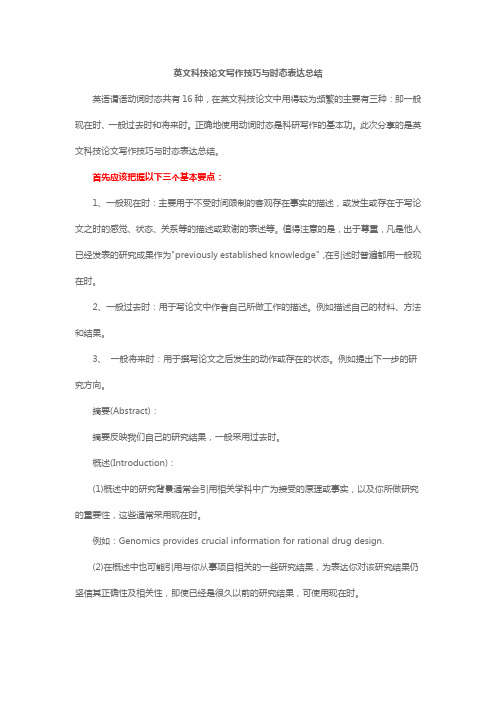
英文科技论文写作技巧与时态表达总结英语谓语动词时态共有16种,在英文科技论文中用得较为频繁的主要有三种:即一般现在时、一般过去时和将来时。
正确地使用动词时态是科研写作的基本功。
此次分享的是英文科技论文写作技巧与时态表达总结。
首先应该把握以下三个基本要点:1、一般现在时:主要用于不受时间限制的客观存在事实的描述,或发生或存在于写论文之时的感觉、状态、关系等的描述或致谢的表述等。
值得注意的是,出于尊重,凡是他人已经发表的研究成果作为"previously established knowledge",在引述时普遍都用一般现在时。
2、一般过去时:用于写论文中作者自己所做工作的描述。
例如描述自己的材料、方法和结果。
3、一般将来时:用于撰写论文之后发生的动作或存在的状态。
例如提出下一步的研究方向。
摘要(Abstract):摘要反映我们自己的研究结果,一般采用过去时。
概述(Introduction):(1)概述中的研究背景通常会引用相关学科中广为接受的原理或事实,以及你所做研究的重要性,这些通常采用现在时。
例如:Genomics provides crucial information for rational drug design.(2)在概述中也可能引用与你从事项目相关的一些研究结果,为表达你对该研究结果仍坚信其正确性及相关性,即使已经是很久以前的研究结果,可使用现在时。
例如:Many of the lakes and wetlands in the region are located in craters or valleys blocked by early Pliocene lava flows (Ollier & Joyce, 1964).Garcia (1993) suggested that under certain conditions, an individual’s deposit income is the same as the income from purchased national debt, thus changes in the amount of bank loans and deposits caused by changes in the amount of reserves will eventually affect the bond price.需要注意的是如果引用的是一些已经过时或失效的科研结果,动词要使用过去时。
英文科技论文不同部分的常见时态
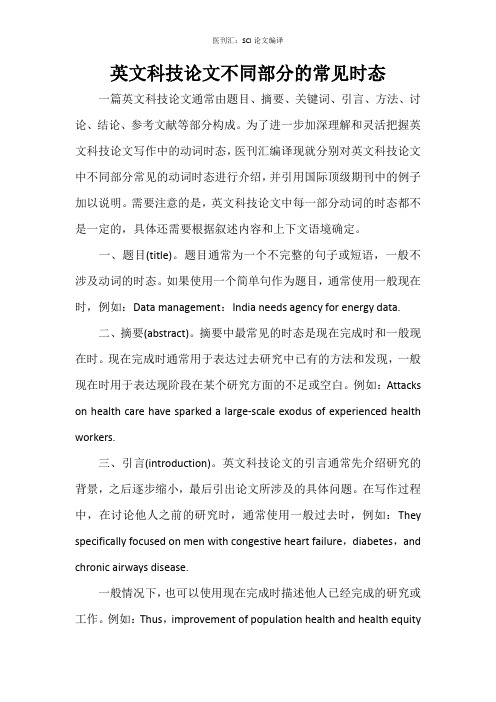
英文科技论文不同部分的常见时态一篇英文科技论文通常由题目、摘要、关键词、引言、方法、讨论、结论、参考文献等部分构成。
为了进一步加深理解和灵活把握英文科技论文写作中的动词时态,医刊汇编译现就分别对英文科技论文中不同部分常见的动词时态进行介绍,并引用国际顶级期刊中的例子加以说明。
需要注意的是,英文科技论文中每一部分动词的时态都不是一定的,具体还需要根据叙述内容和上下文语境确定。
一、题目(title)。
题目通常为一个不完整的句子或短语,一般不涉及动词的时态。
如果使用一个简单句作为题目,通常使用一般现在时,例如:Data management:India needs agency for energy data.二、摘要(abstract)。
摘要中最常见的时态是现在完成时和一般现在时。
现在完成时通常用于表达过去研究中已有的方法和发现,一般现在时用于表达现阶段在某个研究方面的不足或空白。
例如:Attacks on health care have sparked a large-scale exodus of experienced health workers.三、引言(introduction)。
英文科技论文的引言通常先介绍研究的背景,之后逐步缩小,最后引出论文所涉及的具体问题。
在写作过程中,在讨论他人之前的研究时,通常使用一般过去时,例如:They specifically focused on men with congestive heart failure,diabetes,and chronic airways disease.一般情况下,也可以使用现在完成时描述他人已经完成的研究或工作。
例如:Thus,improvement of population health and health equityneeds intersectoral action and social participation,which have been introduced by many Latin American countries.在引言中,涉及一般事实或真理以及表达作者的写作目的时,通常使用一般现在时,例如:Underground injection is probably the easiest route to sequestration.四、方法(method)。
英文科技论文中动词时态使用的方法
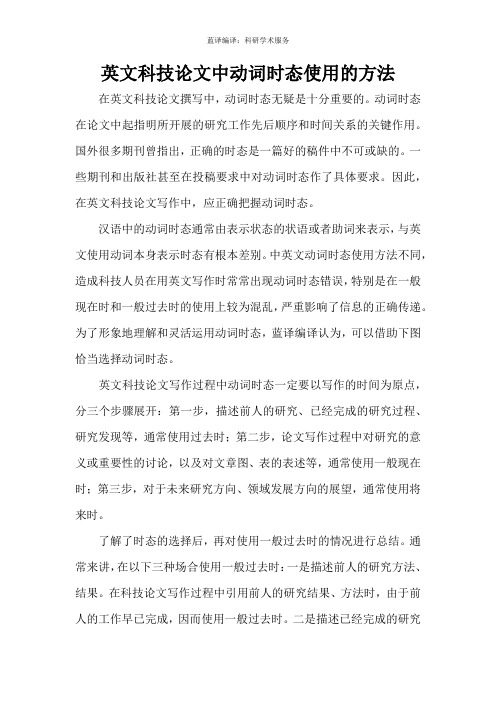
英文科技论文中动词时态使用的方法在英文科技论文撰写中,动词时态无疑是十分重要的。
动词时态在论文中起指明所开展的研究工作先后顺序和时间关系的关键作用。
国外很多期刊曾指出,正确的时态是一篇好的稿件中不可或缺的。
一些期刊和出版社甚至在投稿要求中对动词时态作了具体要求。
因此,在英文科技论文写作中,应正确把握动词时态。
汉语中的动词时态通常由表示状态的状语或者助词来表示,与英文使用动词本身表示时态有根本差别。
中英文动词时态使用方法不同,造成科技人员在用英文写作时常常出现动词时态错误,特别是在一般现在时和一般过去时的使用上较为混乱,严重影响了信息的正确传递。
为了形象地理解和灵活运用动词时态,蓝译编译认为,可以借助下图恰当选择动词时态。
英文科技论文写作过程中动词时态一定要以写作的时间为原点,分三个步骤展开:第一步,描述前人的研究、已经完成的研究过程、研究发现等,通常使用过去时;第二步,论文写作过程中对研究的意义或重要性的讨论,以及对文章图、表的表述等,通常使用一般现在时;第三步,对于未来研究方向、领域发展方向的展望,通常使用将来时。
了解了时态的选择后,再对使用一般过去时的情况进行总结。
通常来讲,在以下三种场合使用一般过去时:一是描述前人的研究方法、结果。
在科技论文写作过程中引用前人的研究结果、方法时,由于前人的工作早已完成,因而使用一般过去时。
二是描述已经完成的研究或者描述研究发现时,应将论文写作时间作为原点,使用一般过去时。
三是描述一个已经不再正确的结果或结论时(英文中描述一个简单事实或者真理时使用一般现在时),可以使用一般过去时,如:Sixteenth-century physicists held that sun revolved around the earth。
在英文科技论文写作中,使用一般现在时的情况:一是描述一个简单的事实(结论),即描述一个被证明是正确的且伴随时间变化不会改变的事实、结果、真理时,使用一般现在时;二是当指向文章本身的图、表等时,使用一般现在时;三是对研究发现进行讨论和对其重要性、意义等进行论述时(一方面是与论文写作同时发生的事,另一方面描述的是一些简单的结论性事实),使用一般现在时。
英语科技论文写作技巧

英语科技论文写作技巧研究现状模块的常用句式研究现状模块,主要阐述其他学者、也包括作者本人与论文要探讨的问题或现象相关的研究工作,通常先“总”后“分”地陈述。
研究现状这部分的目的是引出存在的问题。
“总述”常用一个句子概括相关的研究工作,一般用现在完成时:(1) 用主动语态时,常用researcher /author /investigator /writer 等作主语,如:Many /Several /A number of /Few researchers have studied /investigated /examined/explored /reported on /discussed /considered+ 研究主题.(2) 用被动语态时,常用study /research /investigation /experiment /work/attention 等作主语。
如果描述“研究主题”的单词少,那么“研究主题”可置于句中,如:Many studies /researches /investigationes /experimentes on+ 研究主题+have been performed /done/published .当描述“研究主题”的单词较多时,可置于句末,如:Much work/attention has been performed /done/published on+ 研究主题.用被动语态时,也可用“研究主题”作主语,如:研究主题+has been studied /investigated /examined/explored /reported on /discussed /considered by many investigators /several researchers /a number of authors /few writers .又如:The study of+ 研究主题+has been widely reported /found /published in the literature分述”是具体地介绍他人所做的相关研究成果。
最新英文科技写作技巧与时态表达总结
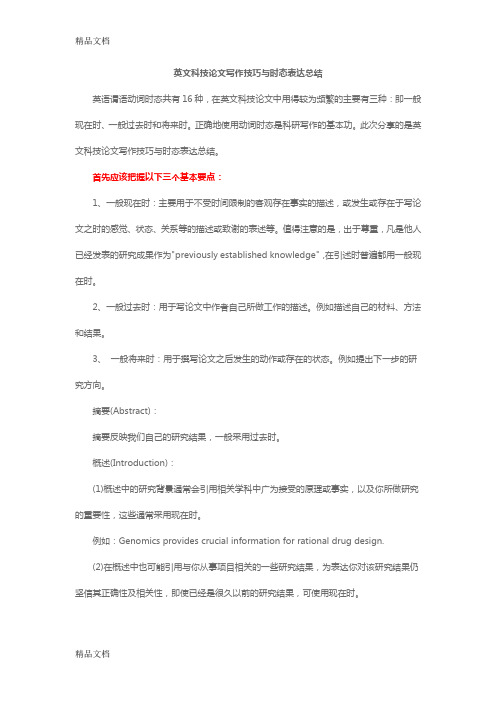
英文科技论文写作技巧与时态表达总结英语谓语动词时态共有16种,在英文科技论文中用得较为频繁的主要有三种:即一般现在时、一般过去时和将来时。
正确地使用动词时态是科研写作的基本功。
此次分享的是英文科技论文写作技巧与时态表达总结。
首先应该把握以下三个基本要点:1、一般现在时:主要用于不受时间限制的客观存在事实的描述,或发生或存在于写论文之时的感觉、状态、关系等的描述或致谢的表述等。
值得注意的是,出于尊重,凡是他人已经发表的研究成果作为"previously established knowledge",在引述时普遍都用一般现在时。
2、一般过去时:用于写论文中作者自己所做工作的描述。
例如描述自己的材料、方法和结果。
3、一般将来时:用于撰写论文之后发生的动作或存在的状态。
例如提出下一步的研究方向。
摘要(Abstract):摘要反映我们自己的研究结果,一般采用过去时。
概述(Introduction):(1)概述中的研究背景通常会引用相关学科中广为接受的原理或事实,以及你所做研究的重要性,这些通常采用现在时。
例如:Genomics provides crucial information for rational drug design.(2)在概述中也可能引用与你从事项目相关的一些研究结果,为表达你对该研究结果仍坚信其正确性及相关性,即使已经是很久以前的研究结果,可使用现在时。
例如:Many of the lakes and wetlands in the region are located in craters or valleys blocked by early Pliocene lava flows (Ollier & Joyce, 1964).Garcia (1993) suggested that under certain conditions, an individual’s deposit income is the same as the income from purchased national debt, thus changes in the amount of bank loans and deposits caused by changes in the amount of reserves will eventually affect the bond price.需要注意的是如果引用的是一些已经过时或失效的科研结果,动词要使用过去时。
sci论文英文写作技巧!

sci论文英文写作技巧!SCI论文对作者的英语水平要求非常高,一篇语言不够好的论文,即使内容再好也会被拒。
因此,作者在撰写SCI论文时,应以英文思维方式写作,注意中西语言表达的差异。
此外,请特别注意以下环节。
一、写作时态英语中谓语动词有16种时态,在英文科技论文中使用较多的主要有3种:一般现在时、一般过去时和将来时。
正确使用动词时态是科技写作的基本功,我们在写英文论文的时候,如果不能正确选择时态,往往会改变文章的意思,影响审稿人和读者的理解。
如何在科技论文中正确使用时态,首先要掌握以下三个基本要点:1.一般现在时:主要用于描述不受时间限制的客观事实,或描述撰写论文时发生或存在的感受、状态、关系等,或表达感谢等。
值得注意的是,出于尊重,凡是他人发表的研究成果在引用时一般使用一般现在时。
2.一般过去时:用于描述作者在论文中所做的工作。
例如,描述你的材料、方法和结果。
3.一般将来时:用于表示写完论文后的动作或存在状态。
比如提出下一步的研究方向。
二、写作语态在科技论文摘要的翻译中,最常用的语态是被动语态。
与主动语态相比,被动语态在科技文摘翻译中具有以下优势:1.科技论文往往需要介绍不以人的意志为转移的客观研究过程和实验结果,使用被动语态更能突出科学研究的客观性。
2.使用被动形式还可以避免提及动作的执行者,从而使动作的研究更具普遍性。
3.由于被动语态的特殊结构,在调整句式结构方面具有更大的灵活性,在增加词组结构、扩展句式信息的同时,有利于保持句式结构的平衡和整齐。
三、SCI论文中最有可能出现的词SCI论文并不要求论文满满的文采,关键是把作者的意思表达清楚,让别人看得懂。
SCI论文中经常出现的词包括动名词和动词,还有现在分词、不定冠词、代词、副词、介词等。
因此,大面用词与其他写法没有太大区别。
但是由于学术论文的学术风格,论文中用词非常正式。
在写作过程中,don’t、can’t及won’t等字眼是很忌讳的。
另外,由于中国人的写作习惯,很多作者经常会出现and so worth及and so on等等,这些词在写英文论文的时候是非常忌讳的。
第三讲 英语科技写作的基本理论和技巧(一)
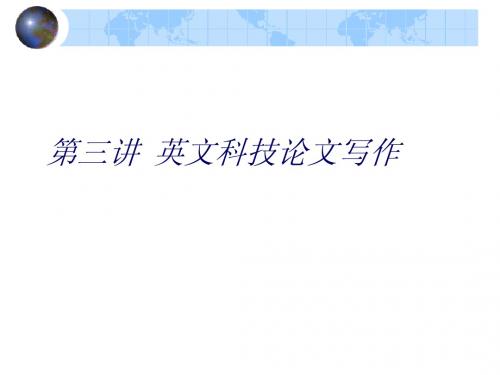
B. 表示增补意义(addition) in addition, furthermore, moreover, and, also, or, too, besides, again, what’s more, likewise C. 表示强调(emphasis) in fact, as a matter of fact, in other words, of course, certainly, above all, indeed, clearly, surely, in particular, obviously, naturally, anyway, in this case D. 表示对照(contrast) while, whereas, in contrast, on the other hand, instead, on the contrary, in spite of, despite, but, however, although, still, yet, nevertheless, conversely, otherwise
I. 表示次序(order) first, second, first of all, to begin with, at first, finally, eventually, in the end, immediately, soon, in front of, next to, opposite to, in the middle of, on the left, afterward, then, next J. 表示结论(conclusion) in conclusion, to conclude, to sum up, to summarize, in summary, in all, in a word, in short, in brief, as has been noted
科技英语写作中的几个小窍门
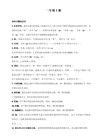
不管是说英文的外国人还是说中文的中国人,用英语进行写作都有很大的难度,因为写作是有规则的,违背这些规则就等于犯错。英文写得好不好,首先要看是不是符合语法,其次是看用词是否恰当,搭配是否合理。因此,如何用英语写作其实是一门高深的学问,一辈子学习都嫌不够。
我本人的英语写作刚入门,而且仅限于科技英语写作。在这里不想“班门弄斧”谈如何写作英语科技论文,只是根据自己的体会,总结一下在英语科技论文写作中的几个小窍门,仅供广大学子参考,恐令学者们见笑。
ቤተ መጻሕፍቲ ባይዱ
八、专有名称
基因与蛋白质的名称一般用相同词汇表示,但基因名称要用斜体,蛋白质名称要用正体。大小写的规定似乎不严格,但基因名称用小写、蛋白质名称用大写较常见。另外,基因工程中的限制性内切酶名称要用斜体,而且第一个字母要大写,但表示菌株来源及酶编号的英文字母及罗马数字用正体,如EcoRI、BamHI等。
七、 拉丁语
科技英语中经常使用拉丁语,一般用斜体表示,如动植物及微生物的拉丁学名、in vivo(活体内)、in vitro(试管中)、in situ(原位)、per se(本身)等。注意:这些外来词用来修饰名词时放在名词前,修饰动词时放在动词后。注意区分They have introduced the in vivo synthesis of vitamin D和Microorganisms are not ordinarily destroyed in vivo by bacteriostatic drugs。不过,有些拉丁词已被当做英语词汇使用,在文章中出现时不用斜体,如et al.和e.g.等。
一、时态的使用
有人在一篇文章中时态的使用很混乱,前后不一致,可能是因为不能活学活用英语语法的缘故。虽然时态错用并不会严重影响读者对文章内容的理解,但体现了作者的写作手法不规范,表达不严谨。一般而言,在Introduction和Discussion中提到一些普遍的认知或常识时,应该用现在时,如Cancer is a disease that fails to control cell division。如果提到别人的发现或报道,可以使用现在完成时,如Those authors have found that …、Someone has reported that …。在Materials and methods和Results中,若涉及动作,通常用过去时,如The wavelength was measured after 10 min。
科技英语作文写作技巧和方法
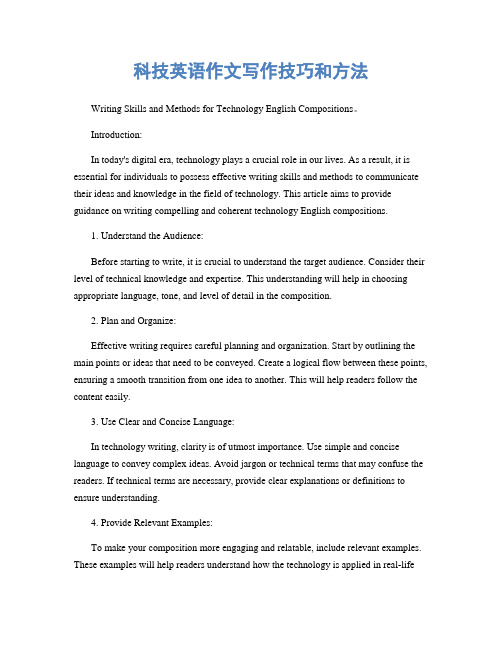
科技英语作文写作技巧和方法Writing Skills and Methods for Technology English Compositions。
Introduction:In today's digital era, technology plays a crucial role in our lives. As a result, it is essential for individuals to possess effective writing skills and methods to communicate their ideas and knowledge in the field of technology. This article aims to provide guidance on writing compelling and coherent technology English compositions.1. Understand the Audience:Before starting to write, it is crucial to understand the target audience. Consider their level of technical knowledge and expertise. This understanding will help in choosing appropriate language, tone, and level of detail in the composition.2. Plan and Organize:Effective writing requires careful planning and organization. Start by outlining the main points or ideas that need to be conveyed. Create a logical flow between these points, ensuring a smooth transition from one idea to another. This will help readers follow the content easily.3. Use Clear and Concise Language:In technology writing, clarity is of utmost importance. Use simple and concise language to convey complex ideas. Avoid jargon or technical terms that may confuse the readers. If technical terms are necessary, provide clear explanations or definitions to ensure understanding.4. Provide Relevant Examples:To make your composition more engaging and relatable, include relevant examples. These examples will help readers understand how the technology is applied in real-lifescenarios. Use specific details and facts to support your ideas, making the content more credible.5. Use Visual Aids:Technology is often complex, and visual aids can significantly enhance understanding. Incorporate diagrams, charts, or graphs to illustrate concepts or data. Ensure that the visual aids are clear, labeled, and directly related to the content discussed.6. Use Active Voice:Using active voice in writing makes the content more dynamic and engaging. It also helps in conveying information more directly. Instead of passive constructions, use active verbs to emphasize actions and responsibilities.7. Edit and Proofread:After completing the initial draft, take the time to edit and proofread the composition. Check for grammatical errors, sentence structure, and coherence. Ensure that the ideas flow logically and that the content is error-free. Reading aloud can also help identify any awkward phrasing or inconsistencies.8. Seek Feedback:To improve the quality of your composition, seek feedback from others. Ask for input from colleagues, friends, or mentors who have knowledge in the field of technology. Their perspectives can help identify areas for improvement and provide valuable insights.9. Stay Updated:Technology is a rapidly evolving field. Stay updated with the latest advancements, trends, and terminology. Incorporate current information into your writing to ensure relevance and accuracy. Regularly reading technology-related articles, journals, or blogs can help expand your knowledge base.Conclusion:Writing compelling and effective technology English compositions requires careful planning, organization, and clarity. By understanding the audience, using clear language, providing relevant examples, and incorporating visual aids, writers can effectively communicate complex technological concepts. Regular editing, seeking feedback, and staying updated are essential for continuous improvement in writing skills. With practice and dedication, anyone can become a proficient technology writer.。
最新英文科技写作表达总结

一.写作时态以前的研究:过去时,自己研究中做过的事:过去时,其他都用:现在时态。
研究发现的可能解释理由用助动词:can, may, might, it seems that, could,研究结果的评论不确定语气:appear, seem, it is likely that,二.词汇和常用表达结构1.图表所示、发现、揭示等as illustrated(seen, shown, observed) in Fig.1, as is evident from, from Fig.2, from the results,by observing Fig.2, based on the above analysis,Fig shows that, the results show,It is (can be) revealed (proved, suggested, observed, found, concluded, noticed, seen, believed) that, it is clear to see/observe that, it indicates(shows, imply) that, find out,it is evident that , it is assumed that , As described below, as seen from, as explained above, as evident from, exhibitit follows that 由此断定…,由此得出结论…point outcast doubt on:对产生怀疑2.得到、获得、obtain, get, attain, capture, acquire, achieve, gain,完成,实现: complete, accomplish, realize,通过什么方式去做,利用/使用through/via/by/with doing sth, using sth,by use of, by means of, make use of, with the aid of use, employ, utilize, adopt, put to use, put into use, apply,影响Affect, influence, impact on, have an effect on,发生,开始,occur, take place, happen, commence, begin, start, to start with, to begin with, at the beginning,显然、明显,Obviously, distinctly, clearly, significantly, apparently, remarkable, as seen, conspicuous,striking, dramatically解释,说明,考虑Explain, account for, allow for,take account for/of, be indicative of (表明,说明)Considering, take into account, with/without/in consideration of, regarding, concerning,描述、提出、说明:Illustrate, manifest, present, show, indicate, cite, describe, summarize, depict, annotate, appear, take on, plot, demonstrate, propose, put forward, put forth,比较大小、多少Less than, greater, more, larger, comparable(可比较的,相当的)经验的Empirical, experimental,做,执行等,Carry out, conduct, perform, do, implement,一致性:Have a good agreement, in good agreement with, match very well with, agree well with, show good agreement, in full agreement with, in line with corresponding to/with, consistent with, in good accordance with, coincide with, concord with, fit well with研究,调查Study, investigate, explore, exploratory examine, make an investigation on/of/into, carry out a research 达到,To reach this objectiveReach, approach, up to, add up to, come to, arrive, beyond, out of reach,验证,假设Validate, verify, justify,hypothesizeAssume, suppose, assumption, hypothesis,assume to be, it is assumed that… postulate 公设增加、上升、减少、下降Increase, decrease, reduce, reduce to, increase by(增加了多少), increase up to(增加到), rise to, give rise to, sth arise, increase with (随…增长/增加)完全地,基本地,详细地,具体地,深入的,类似地,Completely, entirely, adequately, mostly, extremely, truly, indeed, really, actually, mainly, primarily, detailed, in detail, in great detail, in more detail, for more details,Deeper, deeply, better, in depth,similarly, inadequately, notably, overly(过度地、极度地),Experimentally,改善、提高:improve, promote, boost, enhance, facilitate,相关,包括,大约大概:concerned with, relate to, with regard to,精品文档Be involved in/with, with respect to, be concerned with, as for,Around, about, approximately,决定:determine, decide, depend on ,rely on目的、试图:an attempt to, aim at, in an attempt to, the objective is, in order to, the aim of is tothe aim of this research is to do the purpose is , be aimed at,经历,保持: hold, keep, undergo, experience, remain, retain,导致:cause, induce, lead to, result in, originate from, arise from,根据,基于:according to, in terms of, in the light of, judge by, on the basis of, in view of, based on,On behalf of, in the form of, referring to, with reference to, in reference to除了:other than, apart from, with the exception of, except for/that, besides, in addition, additionally,理论上,事实上:in principle, in practice, in fact, in reality, in theory, theoretically,从某种程度上:To some extent, to a large/certain extent, in a way, in a sense, to some degree, in some sense,from the viewpoints of , from the perspective of,得出结论:draw a conclusion, come to/reach a conclusion,推断,猜测:Infer,derive from, deduce, speculate,认为,当作Consider as, regard as, refer to as,建立模型establish, create,build,run/do the simulationin the case of : 在…情况下遵循趋势:obey, follow trend, tendency,组成consist of , contain, be composed of, include,强调:highlight, emphasize, lay emphasis on , the emphasis is layed on集中:focus on, concentrate on , be centered on设定为to set to be辨别、区分:discern,differentiate,identify as, 其他专业词汇表达small batch production, small quantity production, high volume production, mass production,metal-formed product, micro-formed part, reproducibility: 再现性、重复性experimental determination,in particular, especially,评估,评价:evaluate, assess,扮作:act as,分离,隔绝,separate from, isolate, set apart from缺少:in the absence ofby convention:按照传统,惯例,使成为:make sth sthno longer(不再)but rather(相反的)be typical of (典型的)成反比:inversely scale with涉及,牵涉到:involve, cover,拓展:extend into最近,新近more recently,到目前为止,迄今to date,解释、提示原因或结果的转接词:attribute to, because, as a result of, therefore, thereby, in general, consequently, as predicted, in conclusion, since, as for, finally, hence, thus, as, for, due to, in summary, because of, when, cause, on account of, result in, owing to, contribute to, thanks to, lead to, the reason is, that is because, devoted to, accordingly, as a consequence of, arise from起逻辑演进作用的转接词:递进关系,不但…而且…等Furthermore, in addition, besides, first, second, third, finally, lastly, moreover, incidentally, in fact, in truth, as a matter of fact, for example, such as, next, then, for instance, take an instance of , likewise/as such(同样), again(此外), at root, as well as, as follows, in the following, below, based on, above, above-mentioned, aforementioned, as with(正如,与一样,就来说),as noted(正如前面所提到的),additionally, in parallel, as stated( 如上所述)meanwhile:同时对比词,表示逻辑演进方向即将改变如但是等But, however, instead, nevertheless, despite, surprisingly, in spite of, nonetheless, in/by contrast to/with , for comparison, whereas, while, even though,精品文档although, compared with, regardless of, as compared to, with regard to, in relation to, by contrast, irrespective of, in comparison to与联系,联合:in association with同时,同样的,at the same time, in the same way, in the same time对应关系A vs.B versus三.英文研究论文中的表达句子substitute equation (1) into equation (2)把代入等式The scale in Fig (a) runs from black for low values to white for the highest Schmid factors.offers more insight into,holds for all three materials,四.英文科技论文中的语言技巧,不可不看a)如何指出当前研究的不足以及有目的地引导出自己的研究的重要性通常在叙述了前人成果之后,用However来引导不足,比如However, little information..little attention...little work...little datalittle researchor few studiesfew investigations...few researchers...few attempts...or nonone of these studieshas (have) been lessdone on ...focused onattempted toconductedinvestigatedstudied(with respect to)Previous research (studies, records) has (have) failed to considerignoredmisinterpretedneglected tooverestimated, underestimatedmisleadedthus, these previous results areinconclusive, misleading, unsatisfactory, questionable, controversial..Uncertainties (discrepancies) still exist ...这种引导一般提出一种新方法,或者一种新方向。
- 1、下载文档前请自行甄别文档内容的完整性,平台不提供额外的编辑、内容补充、找答案等附加服务。
- 2、"仅部分预览"的文档,不可在线预览部分如存在完整性等问题,可反馈申请退款(可完整预览的文档不适用该条件!)。
- 3、如文档侵犯您的权益,请联系客服反馈,我们会尽快为您处理(人工客服工作时间:9:00-18:30)。
英文科技论文写作技巧与时态表达总结
英语谓语动词时态共有16种,在英文科技论文中用得较为频繁的主要有三种:即一般现在时、一般过去时和将来时。
正确地使用动词时态是科研写作的基本功。
此次分享的是英文科技论文写作技巧与时态表达总结。
首先应该把握以下三个基本要点:
1、一般现在时:主要用于不受时间限制的客观存在事实的描述,或发生或存在于写论文之时的感觉、状态、关系等的描述或致谢的表述等。
值得注意的是,出于尊重,凡是他人已经发表的研究成果作为"previously established knowledge",在引述时普遍都用一般现在时。
2、一般过去时:用于写论文中作者自己所做工作的描述。
例如描述自己的材料、方法和结果。
3、一般将来时:用于撰写论文之后发生的动作或存在的状态。
例如提出下一步的研究方向。
摘要(Abstract):
摘要反映我们自己的研究结果,一般采用过去时。
概述(Introduction):
(1)概述中的研究背景通常会引用相关学科中广为接受的原理或事实,以及你所做研究的重要性,这些通常采用现在时。
例如:Genomics provides crucial information for rational drug design.
(2)在概述中也可能引用与你从事项目相关的一些研究结果,为表达你对该研究结果仍坚信其正确性及相关性,即使已经是很久以前的研究结果,可使用现在时。
例如:Many of the lakes and wetlands in the region are located in craters or valleys blocked by early Pliocene lava flows (Ollier & Joyce, 1964).
Garcia (1993) suggested that under certain conditions, an individual’s deposit income is the same as the income from purchased national debt, thus changes in the amount of bank loans and deposits caused by changes in the amount of reserves will eventually affect the bond price.
需要注意的是如果引用的是一些已经过时或失效的科研结果,动词要使用过去时。
例如:Nineteenth-century physicians held that women got migraines because they were "the weaker sex," but current research shows that the causes of migraine are unrelated to gender.
(注意这里从过去时态过渡到现在时态)
材料与方法(Materials and Methods):
对写论文之前自己所做工作的描述,通常采用一般过去时。
例如:(例1) Total phosphorous (TP) and total nitrogen (TN) were measured in the laboratory using standard procedures.
(例2)The standard protocol was followed for the preparation of the media from stock solutions.
结果(Results):
对自己得出的研究结果,采用过去时进行详细的阐述。
例如:(例1)Overall, more than 70% of the insects collected were
non-phytophagous.
(例2) Following activation of NT oocytes with strontium, the cell cycle resumed in both groups.
描述图表内容通常采用现在时。
例如:(例1) Figure 1 displays the comparative variation in the morphology of donor chromatin in both age groups of oocytes.
(例2) Table 1 below shows the stream flows calculated for each stream using Equation 1.
图1和表1表达的论文写作时的状态,所以要用现在时。
讨论(Discussion):
采用现在时表达研究结果的意义。
例如:Removal of vegetation for agricultural purposes appears to negatively affect the water quality of streams.上学吧论文查重
采用过去时总结研究结果,并采用现在时对研究结果进行讨论与解释。
例如:(例1)Weight increased as the nutritional value of feed increased. These results suggestthat feeds higher in nutritional value contribute to greater weight gain in livestock.
(注意这里用过去时描述了实验发现,但在讨论这个发现的意义时用的是现在时。
) (例2)Leaf carbon and phenolic content did not differ across sites, indicating that the response of
secondary plant chemicals such as phenolics to water is complex.
(这句的描述几乎没有假设的意思,表示作者坚信其研究结果和结论的正确性及相关性)
结论(Conclusion):
可用多种时态,使用过去时强调过去的研究成果,并可采用现在时或将来时表达未来的研究方向或研究前景。
例如:Although the study found evidence of tillage and irrigation within the study area, from the data collected it was not possible to determine if the effects of agriculture upstream cause (or caused) higher levels of total nitrogen downstream. Further studies are therefore necessary to determine the effects of agriculture on the health of Stringybark Creek.。
